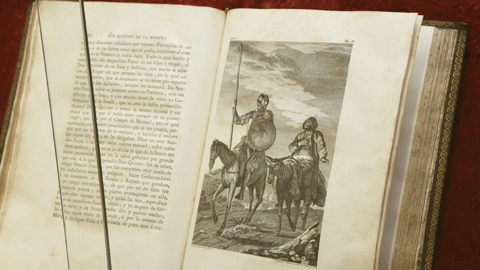"Quixotes of the Autònoma" exhibition opens at UAB
The "Quixotes of the Autònoma" exhibition can be visited at the UAB exhibitions hall (Communication Library) from 9 November to 16 December. The exhibition was opened on the 9th by Francisco Rico and Eduardo Mendoza, followed by a musical performance by Jordi Savall.

At the opening, which took place on 9 November, Prof. Rico gave a talk to present the contents of the exhibition. He recounted anecdotes and curiosities about the publishing and distribution of Cervantes' work, paying particular attention to the process that led "The Ingenious Gentleman Don Quixote of La Mancha" to become a classic, and mentioning editors, illustrators and other figures linked to quixotism. He also praised the bibliographic "treasures" that Barcelona possesses, claiming that this city is "the most Cervantine of all".
The novelist Eduardo Mendoza, who gave the opening address, said that "for book lovers and lovers of the Quixote, this exhibition is almost an amorous occasion". In his view the work "unleashes a torrent of ideas and and transforms the genre" of the novel, and it continues to be "the point of reference for all of us who are writing today". Referring to his own experience, he explained how he "immediately became addicted" to the book on first encountering it, and he stressed how valuable the annotated edition by Francisco Rodríguez Marín had been to him.
The opening ceremony included a performance by Jordi Savall (viol) and his son Ferran Savall (voice and theorbo), of songs and dances from the times of Miguel de Cervantes. They played "Paxarico tu te llamas", by an anonymous Sephardic author, "Marinero soy de amor", by Miguel de Cervantes, a "Morisca" dance by an anonymous author, the improvisation "Canarios" and "Passamezzo moderno", by Diego Ortiz.
An educational exhibition
The Quixote exhibition places great emphasis on visual clarity and instructive value. There are materials from all periods, from the publication of the first part of the novel onwards, and visitors can easily follow the changes in the way the book has been printed over the centuries: quarto editions for the well-to-do reader, the first editions to be illustrated with engravings, the pocket-sized editions for a mass market, the transformation into a universal literary classic, the great artistic interpretations of the 19th and 20th centuries, and the all-important translations.
Among the highlights of the exhibition are the 1605 Valencia edition, the first Spanish edition in small format; the 1636-1637 Madrid editions and the 1662 Brussels edition, which most subsequent ones are based on; the splendid London edition of 1738 which already treats the work as a classic, in the text and in the illustrations; the extremely elegant Hague edition of 1744, and many more.
As well as the books themselves, the exhibition includes outstanding illustrations and an audiovisual on adaptations of the work.